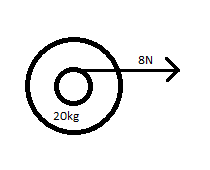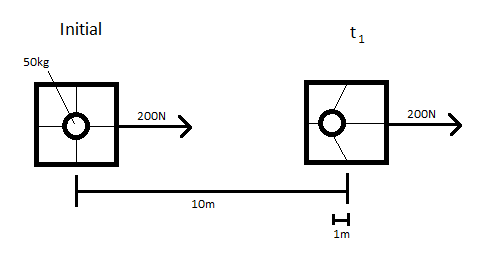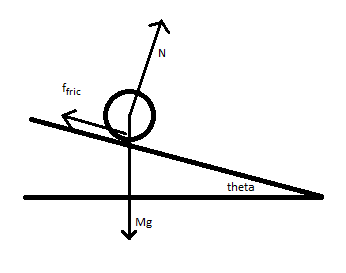Real Systems
This page describes real systems and how they can be used to model certain aspects of a system's motion.
The Main Idea
A real system is a system in which every part of the system is modeled separately, allowing for the internal behaviors of the system to be analyzed in addition to the system's motion through its environment.
In Point Particle Systems, forces are analyzed as though they act directly on the system's center of mass, and only the translational kinetic energy of a system can change. Through week 9, we have modelled most bodies as point particles, as we have been primarily interested in their translational motion. However, we may now encounter problems where we want to analyze the internal behaviors of systems as well. For example, we may want to calculate a change in a system's Translational, Rotational and Vibrational Energy, Potential Energy, or Thermal Energy. In a real system, the point of application of each force must be considered. Furthermore, when calculating the work done by a force, the distance over which the force is applied is not the distance traveled by the system's center of mass, but rather the distance traveled by the force's point of contact. These two key differences lead to a mathematical model that can be more complicated than that of a point particle system, but yields insights about the internal behavior of the system.
A Mathematical Model
The mathematical concepts used to analyze point particle systems depend on the system. Often, the work-energy theorem is used. This section explains how to use the work-energy theorem for a point particle system because this is the concept that varies the most significantly from its application to point particle systems.
The work done on a real system should be calculated separately for each force acting on it because each force might be exerted over a different distance due to the geometry of the system. The work done on a real system by each force is defined as
[math]\displaystyle{ W = \int \vec{f} \cdot d \vec{r} }[/math],
where [math]\displaystyle{ \vec{r} }[/math] is the position of the point on the system on which the force acts.
Let us assume that the force acting on the system is constant, so that we can get rid of the integral, and that the force acts in the direction of the system's motion, so that we can replace the dot product with regular multiplication. This will be the case for most real system problems involving work. With these assumptions, the work done on a part of a real system by a force is given by
[math]\displaystyle{ W = f * d }[/math]
where [math]\displaystyle{ F_{net} }[/math] is the magnitude of the net force acting on the particle and [math]\displaystyle{ d }[/math] is the distance over which the force is exerted. For real systems, that is the distance traveled by the point of contact of the force, which may not be the same as the distance traveled by the system's center of mass, depending on the movement of the systems' different parts. This contrasts with point particle systems, where the distance over which the force is exerted is simply the displacement of the system's center of mass.
The work-energy theorem states that work done on a system increases that system's energy. For real systems, this is the system's total energy. Since each force's work must be found separately in a real system, remember to sum the values of the work done by the different forces acting on the system.
In other words, for a real system,
[math]\displaystyle{ \Delta E = \sum_i f_i * d_i }[/math].
The equation above is the basis for answering work/energy questions using real systems. It is important to remember that when modeling a system as a real system, calculating the work done on the system as described above finds all of the work done on the system- both translational kinetic energy and internal types of energy.
A Computational Model
Most computer simulations treat systems as real systems, modeling each part of a system separately. This is because Iterative Prediction makes keeping track of each part of the system separately easy even when it might be difficult to do so analytically. The last example on the Point Particle Systems page describes a system in which two masses are connected by a spring and one of them is pulled by a force. Consider the following simulation of the system:
If you click "view source" on the top left corner, you will see that the process of iterative prediction is performed separately for each of the two masses- they each have their own position vectors, and the forces acting on each are calculated. There is no need to treat them as a single particle and thereby lose information about their internal behavior- in this case, their oscillations.
Examples
Some of the examples on the Point Particle Systems page can also be analyzed as real systems. Modeling each system as a real system makes the math more complicated but allows us to calculate the internal energies of the systems. Let us look at each example from the point particle systems page. (If you haven't already looked at them on the point particle systems page, do that first.)
1.
A 60kg person jumps straight up in the air from a crouching position. From the time the person begins to push off of the ground to the time their feet leave the ground, their center of mass moves up 2m, and the normal force between the ground and the person's feet has a constant magnitude of twice the person's weight. Find the velocity of the jumper at the moment their feet leave the ground. Use 10m/s2 for g.
In this problem, the internal energy of the person does not change, so modeling the jumper as a real system offers few advantages. In fact, it makes it difficult to take an energy approach to answer the question, since when the person is modeled as a real system, the point of contact of the normal force does not move and so does not do work. Instead, forces in the person's legs do work, but the amount of work they do is difficult to calculate since different parts of the legs move different amounts. This problem is best analyzed as a point particle system.
2.
A giant 20kg yo-yo floats at rest in space. Its string (whose mass is negligible compared to the mass of the yo-yo) is pulled with a constant force of 8N. What is the speed of the yo-yo when it has travelled 5m?
This problem can be analyzed as a real system, although it requires knowledge of rotational physics and is more difficult than treating it like a point particle.
The work done on the yo-yo is no longer simply 40Nm because the point of the force's application travels faster than the yo-yo's center of mass due to the yo-yo's rotation. It makes sense that the work done on the real yo-yo is greater than the work we found when treating it as a point particle because this work includes the increase in its rotational kinetic energy as well as the increase in its translational kinetic energy Let us find the distance over which the force is exerted in the real system.
Because the force applies a constant torque, the yo-yo undergoes constant angular acceleration [math]\displaystyle{ \alpha }[/math]. Let us say it takes [math]\displaystyle{ t_1 }[/math] seconds for the yo-yo to travel the 5m. The average angular velocity of the yo-yo over that time period is
[math]\displaystyle{ \omega_{avg} = \frac{1}{2} \alpha t_1 }[/math].
This means that the distance traveled by the point of contact between the yo-yo and the string due to the yo-yo's rotation during the [math]\displaystyle{ t_1 }[/math]-second interval is given by
[math]\displaystyle{ d_{rot} = \frac{1}{2} \alpha {t_1}^2 r }[/math],
where r is the radius of the yo-yo (the radius of the string wrapping around it, not the radius of its outer rim).
The total work done on the yo-yo is given by
[math]\displaystyle{ W = f * (d_{trans} + d_{rot}) }[/math] ([math]\displaystyle{ d_{trans} }[/math] is the 5m traveled by the yo-yo's center of mass and [math]\displaystyle{ d_{rot} }[/math]) is the distance traveled by the edge of the yo-yo due to its rotation, found above.)
[math]\displaystyle{ W = f * (d_{trans} + \frac{1}{2} \alpha {t_1}^2 r) }[/math].
Let us manipulate this expression. Let us start by distributing out the force at the beginning:
[math]\displaystyle{ W = f * d_{trans} + f * \frac{1}{2} \alpha {t_1}^2 r }[/math].
The second term has both f and r as factors. Since the product of these two is the torque exerted by the force, we can replace [math]\displaystyle{ f*r }[/math] with [math]\displaystyle{ T }[/math] for torque:
[math]\displaystyle{ W = f * d_{trans} + \frac{1}{2} \alpha {t_1}^2 T }[/math].
Next, since [math]\displaystyle{ T = I\alpha }[/math] for fixed-plane rotations, we can replace [math]\displaystyle{ T }[/math] with [math]\displaystyle{ I\alpha }[/math], where [math]\displaystyle{ I }[/math] is the moment of inertia of the yo-yo:
[math]\displaystyle{ W = f * d_{trans} + \frac{1}{2} \alpha^2 {t_1}^2 I }[/math].
Finally, we can replace the product [math]\displaystyle{ \alpha * t_1 }[/math] with [math]\displaystyle{ \omega_1 }[/math], the angular velocity of the yo-yo when it reaches the 5m mark:
[math]\displaystyle{ W = f * d_{trans} + \frac{1}{2} I {\omega_1}^2 }[/math].
This expression is the amount of work done on the yo-yo, and since its initial energy of the yo-yo is 0, this expression also gives the final total energy of the yo-yo. Some of it is translational kinetic energy, and some of it is rotational kinetic energy. We recognize the expression [math]\displaystyle{ \frac{1}{2} I {\omega_1}^2 }[/math] as the final rotational kinetic energy of the yo-yo, so that leaves [math]\displaystyle{ f * d_{trans} }[/math] as the final translational kinetic energy of the yo-yo. This is 8 * 5 = 40 Joules, which is the same value for the final translational kinetic energy of the yo-yo that we got by analyzing the yo-yo as a point particle on the point particle systems page. The yo-yo's translational speed can be easily calculated from this value.
As you can see, we were able to save a lot of work by treating the yo-yo as a point particle system.
3.
A 50kg metal sphere is suspended in the inside of a large cubic box of negligible mass by six rubber bands- one attaching the sphere to each face of the box. The box and the sphere are initially at rest. A 200N rightward force is applied to the side of the box, causing it to accelerate. At time [math]\displaystyle{ t_1 }[/math], the box has been displaced by 10m to the right. At this time, the sphere is no longer exactly in the center of the box; it is 1m to the left of the center of the box due to its inertia. What is the speed of the sphere at time [math]\displaystyle{ t_1 }[/math]?
Analyzing this system as a real system allows us to see that 2000Nm of work was exerted on the system rather than the 1800nM found using a point particle system. This is because the point of the force's application is on the box, which traveled all 10m. The 1800J found using the point particle system is the translational kinetic energy of the sphere, and the remaining 200J was an increase in the potential energy of the rubber bands, which became stretched when the sphere was displaced by 1m. This energy may become vibrational as the light box jiggles around the sphere.
4.
A uniform disk of mass [math]\displaystyle{ M }[/math] starts at rest and rolls without slipping down a ramp. The plane of the ramp makes an angle of [math]\displaystyle{ \Theta }[/math] with the horizontal. The force of Static Friction acting on the bottom of such a disk, causing it to rotate, always has a magnitude of 1/3 the force acting to move the disk down the ramp. What is the translational speed of the disk after it has traveled a distance of [math]\displaystyle{ d }[/math] diagonally down the ramp?
Using a point particle system, we calculated the work done by the net force acting on the particle. The net force had a magnitude of
[math]\displaystyle{ f_{net} = \frac{2}{3} Mg \sin \Theta }[/math].
However, when treating the disk as a real system, the work done by the friction force and by the gravitational force need to be calculated separately because the forces act on different parts of the system and are exerted over different distances. The work done by the gravitational force is
[math]\displaystyle{ W = Mg \sin \Theta * d }[/math],
since the gravitational force force acts on the center of the disk's mass, which travels a distance of d.
The work done by the friction force, however, is actually 0. This is because the friction force is applied to the point on the edge of the disk: the point that is in contact with the ramp. Since the disk rolls instead of slides and is affected by Static Friction with the ramp, this point is not moving relative to the ramp, and so the friction force is exerted over a distance of 0.
When modeling the disk as a real system, therefore, the final energy of the disk is
[math]\displaystyle{ E = Mg \sin \Theta * d }[/math].
This is higher than the energy found when we treated the disk like a point particle system because this energy includes both translational kinetic energy and the rotational kinetic energy of the disk.
Let us find (without looking at our answer from the point particle analysis) how much of this energy is rotational and how much is translational. Let us say that the final translational speed of the disk is [math]\displaystyle{ v }[/math].
In that case, the translational kinetic energy of the disk is given by
[math]\displaystyle{ KE_{trans} = \frac{1}{2}Mv^2 }[/math]
and the rotational kinetic energy of the disk is given by
[math]\displaystyle{ KE_{rot} = \frac{1}{2}I \omega^2 }[/math]
[math]\displaystyle{ KE_{rot} = \frac{1}{2} \frac{1}{2}MR^2 (\frac{v}{R})^2 }[/math] where R is the radius of the disk.
[math]\displaystyle{ KE_{rot} = \frac{1}{4} M v^2 }[/math]
[math]\displaystyle{ KE_{rot} = \frac{1}{2}KE_{trans} }[/math], so 2/3 of the disk's kinetic energy is translational and 1/3 is rotational.
This means the translational kinetic energy of the disk is
[math]\displaystyle{ E = \frac{2}{3} Mg \sin \Theta * d }[/math].
This is the same value for the final translational kinetic energy of the disk that we got by analyzing the disk as a point particle on the point particle systems page. The disk's translational speed can be easily calculated from this value.
5.
A pair of 10kg masses are connected by a massless spring of unknown spring constant. They begin at rest at the spring's equilibrium length. A 30N rightward force is applied to the mass on the right for 4s. At the end of the 4 second period, the force ceases to act and the mass on the right has traveled 20m. The system continues to travel to the right, and the distance between the two masses oscillates sinusoidally. How much vibrational kinetic energy does the system have? (Vibrational kinetic energy is the energy of the mass' oscillatory movement, as opposed to their translational kinetic energy, which is the energy of the rightward movement of their center of mass.)
Here is a simulation of the system to help you visualize it.
By modeling the system as both a real system and a point particle system (which was done on the point particle systems page), we are able to answer the question. Finding more detailed information about the oscillations, such as their frequency, amplitude, and phase, is much more difficult and requires an entirely real model. A difficult-to-solve system of differential equations would have to be devised, describing the accelerations of the masses in terms of their positions.
See also
External links
A helpful page for additional info: http://p3server.pa.msu.edu/coursewiki/doku.php?id=183_notes:pp_vs_real
A helpful video lecture: https://www.youtube.com/watch?v=T780lL5FlLg&index=41&list=PL9HgJKLOnKxedh-yIp7FDzUTwZeTeoR-Y
References
Chabay, Ruth W., and Bruce A. Sherwood. "9." Matter & Interactions. N.p.: n.p., n.d. N. pag. Print.



